

DIY Thomas the Train Costume – Craftulate. This Thomas the Train Costume is perfect for a train-themed party or Halloween!
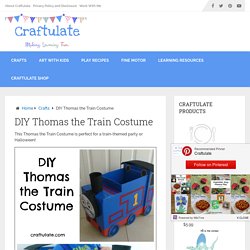
The following post contains affiliate links, which means that at no extra cost to you I can make a tiny bit of money to help support this blog. Thank you! When my son was aged 1.5 at Halloween, I decided he should be a pirate. The following year he was dressed as Bob the Builder. Neither year he was very convinced by the whole costume idea. 5 Reasons Why Playing With Animal Figurines Is Beneficial For A Child – Fun Montessori Toys. Animal figurines are open-ended toys that have been with us for centuries.
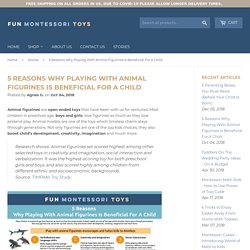
Most children in preschool age, boys and girls, love figurines as much as they love pretend play. Animal models are one of the toys which timeless charm stays through generations. Not only figurines are one of the top kids choices, they also boost child’s development, creativity, imagination and much more. Research shows: Animal figurines set scored highest among other selected toys in creativity and imagination, social interaction and verbalization. Playing with Toy Cars, Trains, Boats and Planes - Good Play Guide : Good Play Guide. Toy vehicles have been a staple part of the toy box for years, from simple wooden wheeled toys for infants, to high-tech remote control cars.

Here are some of the benefits of toy cars, trains, boats and planes: Pretend play Children come across vehicles frequently in their daily lives, so they like to incorporate these in small world play, too. 6 Ways to Play with Toy Cars. One or two toy cars quickly became ten, and then twenty, and now we have so many cars we barely have room to store them!

Over the years our ever expanding collection of toy cars has been enjoyed with by all our four children, and currently our youngest, three year old Noah, is totally obsessed with them! Cars are a simple, cheap, accessible toy and can be used in so many ways. Here are six of our favourite ways to play. 1. Developmental Skills while Playing With Cars – waytoplay.toys. How children benefit from playing with toy cars. How Children Benefit From Pretend Play Kitchen, Stores, And More. Once upon time, you may have worn your mother’s favorite apron while arranging miniature tea sets on a tiny table, serving imaginary tea and scones to your favorite doll.
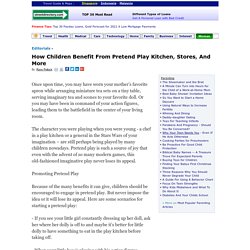
Or you may have been in command of your action figures, leading them to the battlefield in the center of your living room. The character you were playing when you were young - a chef in a play kitchen or a general in the Stars Wars of your imagination – are still perhaps being played by many children nowadays. Pretend play is such a source of joy that even with the advent of so many modern games, this old-fashioned imaginative play never loses its appeal. Promoting Pretend Play Because of the many benefits it can give, children should be encouraged to engage in pretend play. Moving Smart: WHAT CARDBOARD BOXES CAN TEACH KIDS. Like red rubber balls and teddy bears, broccoli refusals, skipping rope, sticky fingers, boo boo kisses, bath time pouts, and nighty night tuck ins, I think cardboard boxes are essential kit for little kids.
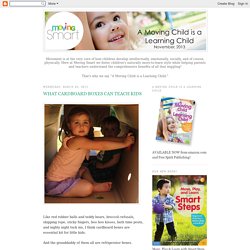
And the granddaddy of them all are refrigerator boxes. Guess what arrived at my house the other day? (he-he-he!) After a day with my grandchildren and a big cardboard box, it got me thinking about why kids love cardboard boxes, and why cardboard boxes are great for kids... Playing with cardboard boxes: 2-6 years. Playing with cardboard boxes: why it’s good for children A big empty box is a great starting point for creative and imaginative play.
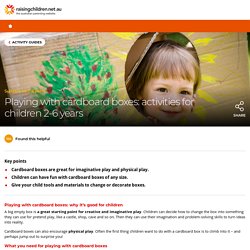
Children can decide how to change the box into something they can use for pretend play, like a castle, shop, cave and so on. Then they can use their imagination and problem-solving skills to turn ideas into reality. Cardboard boxes can also encourage physical play. Often the first thing children want to do with a cardboard box is to climb into it – and perhaps jump out to surprise you! Learning through Play: 14 Developmental Milestones with Fun Activities. 13 Ways to Learn with Everyday Objects. 26 Common Household Items That Make Cheap Baby & Toddler Toys - Teaching Littles.
Ever offer your baby several of their colorful, musical, toys, but they make a mad dash for the Tupperware drawer or remote control, instead?
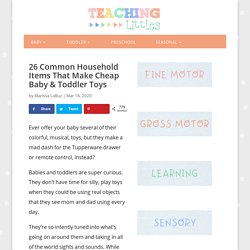
Babies and toddlers are super curious. They don’t have time for silly, play toys when they could be using real objects that they see mom and dad using every day. They’re so intently tuned into what’s going on around them and taking in all of the world sights and sounds. While you may not see it, they are watching your every move like a hawk. They’re picking up on the things that you do and say, from how you greet your partner when they walk in the door to how you brush hair. 3 Reasons to Encourage Toddlers to Play With Everyday Objects More - infokids.com.au. When a child is born to a family consumed with love for him or her, it is easy to use that love as a reason to shower the child with toys that will delight.

When relatives and friends join in, a child can soon possess an overwhelming array of toys. When there are no real means to buy child plenty of toys, parents may worry that their child is missing out on good quality play. However, this is far from true. Children do not need as many toys as most people think. What Children Can Learn From Everyday Objects. We can nurture children’s development using inexpensive and readily available resources, say Russell Grigg and Helen Lewis… Picture the scene.
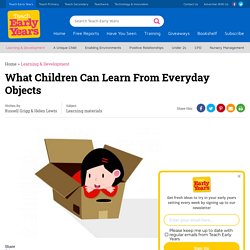
December 25th is fast approaching, and parents are rushing around trying to find the latest must-have toy for their young children. 20+ Ways to Play with Plastic Animals. Playing with balls: activities 3-6 years. Playing with balls: why it’s good for children Playing with balls makes physical activity fun. Also, throwing, catching, rolling and kicking balls: works arm and leg musclesimproves hand-eye coordinationincreases fitness.
When children practise ball skills, they’ll notice their skills improving. This helps children understand that they can learn and get better at something if they try. What Are The Benefits Of Sand & Water Play In Early Childhood? What Are The Benefits Of Sand & Water Play For Toddlers In Early Childhood Development? There are many benefits of sand and water play for toddlers in their early childhood development. Here are just 5 of the surprising benefits: Enhances motor skillsImproves language and speechEnhances social and emotional awarenessIntroduces concepts of mathematics and scienceSparks creativity So rest assured when your littles ones are being drawn to the sand and water play it is a great learning opportunity, using their senses to learn and develop!
How young children learn English through play. As we release Learning Time with Timmy – our first app for early-years learners of English – Danitza Villarroel, a teacher on our Learning Time with Shaun and Timmy course in Chile, explains the importance of learning through play, and offers a few tips for teachers new to this age group. Teaching English to pre-school children can be daunting for teachers new to this age group. Young children have shorter attention spans than older children and adults, and they're still learning their mother tongue.
But teaching these learners can be enormously rewarding once you've taken a few basic principles on board. Games That Encourage Language Development in Early Childhood. Parents are all-too familiar with the competitive undertone of milestone stories. “She was reading at 3!” Is subtly countered by, “He was walking at 1!” While parents may differ in how they choose to celebrate these milestones, what is universally true is that their involvement plays a large role in crossing these milestones, especially in the case of language development in early childhood; a child’s vocabulary is directly proportionate to the number of words they’re exposed to in the early months. Helping Children Build Language Skills.
Preschool: That Sounds Silly! Four-year-old Adam runs to his teacher and says, "I see the sky with my eyes! What color is the sky? " She responds, "What color do you think the sky is, Adam? " "Blue, blue-blue, blue, blue! " Adam replies in a singsong way. 5 Fun Activities for Language Development – Reading Eggs. Helping Toddlers Expand Language Skills. Building Language and Literacy Through Play. Supporting speech development through play. The Importance of PLAY for Speech and Language Development {With Tips} - Playing With Words 365. Toys to Help with Language Development for Toddlers and Preschoolers. Language development: children 0-8 years. 5 Simple Language Play Ideas for Language Development. Fun activities that help develop language learning in children. How to facilitate language development through play. Deconstructing Role Play – Provide the Resources, Step Back and Watch Children’s Learning Flourish.
Symbolic play and language development. NPR Cookie Consent and Choices. The cognitive benefits of play: Effects on the learning brain. Low-cost play ideas & materials. Primary school shake-up to focus on ‘play-led’ learning. Why Movement is Essential in Early Childhood. Play to Learn: Discussion. Play to Learn. Convention on the Rights of the Child. Taking Playtime Seriously. Importance of play for babies & children. Play.
Teachers TV- How Do They Do It In Sweden? Getting the right balance between adult-led and child-initiated learning. 6 Types of Play: How Children's Play Becomes More Social.